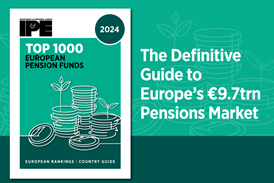- The productivity gap between Europe and the US has widened and cannot just be explained by the tech sector
- German economic woes may spill over to neighbours
- The UK has a unique issue in a rising labour share of national output
- These factors make Europe and the UK unattractive as an investment destination
- New capital will be needed to boost European competitiveness, not just recycled pension assets
Jean Frijns and Anton van Nunen’s recent article in IPE advocates increased investment by pension funds as a solution to the issues raised in the Draghi report on European competitiveness, notably low productivity.

However, since the Draghi report was written and published, global geopolitics and economics have been thrown into turmoil. The problem of low productivity growth and an increasing gap with the US is common to continental Europe and to the UK. Similar to the Frijns/Van Nunen proposals, the UK chancellor’s response to persistent low productivity has also been to promote investment in productive assets by UK pension schemes.
Converging and diverging productivity gaps
Until the 1990s, European nations, including the UK, were actively closing the productivity gap with the US. However, this trend has not only stopped but the divergence between continental Europe and the UK compared to the US is growing. US per capita income is now some 20% higher than its equivalent in the major European economies, France and Germany, and the gap is even wider in other European states.
The demographics of ageing are among the principal causes of this reversal. Europe is ageing much more rapidly than the US, and this difference in demographics is in large part due to the high levels of immigration, legal and illegal, to the US.
Projections of the German working age population and old-age dependency ratio illustrate this issue. The former is expected to decline from 52m to 43m by 2050 and the latter to deteriorate from 34% to 51%. Against this background, the proliferation of anti-immigration policies we are seeing in the US, as well as in Europe, though electorally rewarding, is a highly questionable and shortsighted approach economically.
Innovation and growth
It should also be recognised that the issue facing Europe is one of low total factor productivity rather than low capital intensity.
Innovation and growth among large listed European technology companies have been far lower than among their US counterparts. In the past two decades, the productivity gains of the US tech sector have been around 40%, while listed European ‘tech’ firms have experienced little or no improvement.
The larger productivity gains in the US have also not been limited to the tech sector. Indeed, the large non-tech US sectors have shown larger productivity gains over the past 20 years compared to the US tech sector[1]. Over this period, the US tech sector stands out for its huge and increasing R&D expenditures as a proportion of sales. Of course, much of this has been AI-related, with stock market valuations soaring. However, it now appears that the profits and growth of the US tech giants are decelerating, and we have seen Microsoft pull back from its proposed data centre investment projects, citing concerns over the forecast economic benefits of AI.
As a countertrend, it appears that, in the past few years, the tech giants have been able to entrench their market power, often through acquisitions, and with that slowed innovation – a failure of antitrust policy.
It is rather surprising against this backdrop, therefore, that UK government policy is seeking to develop large-scale capabilities in AI and data centres – and looking for it to be mainly funded by private investment. Particularly so, given the extremely high costs of electricity and the parlous state of the UK water utilities, the two principal operating inputs of a data centre.
An increasingly uncertain future
While uncertainty is something that is often talked about, and quite often experienced – such as the Global Financial Crisis (GFC) or COVID – the uncertainty introduced into world affairs by the Trump presidency is unprecedented. If we consider first the proposal to renew and perhaps extend the tax breaks introduced by Trump in 2017, we may expect the borrowing cost of the taxes forgone to be far larger than the US Medicaid bill, as US Treasury rates are now far from the zero lower bound where they were in 2017 when these cuts were first implemented.
Those measures did provide a boost to US growth of perhaps 10% over the long run, but their cost far exceeds the incremental tax receipts from that growth – perhaps 15% of the tax cost which is estimated at $120bn (€111bn). Further cuts in tax rates will also lower the attractiveness of investment incentives. However, as with the previous cuts, they are likely to prove inflationary.
Until recently, most academic analyses of trade dependencies focussed on imports from China. It is clear there will be differential trade effects from tariffs. For highly substitutable goods such as food, agricultural products, and motor vehicles, the effects on European exporters are likely to be challenging. However, it is worth noting that there is a pronounced imbalance in complex and therefore non-highly substitutable goods - by one estimate the US relies on the EU for 32 strategically important products, while the EU relies on the US for only eight[2].The suppliers of these goods should be relatively unaffected by tariffs.
Come what may in terms of the split of the tariff costs between supplier, importer, and consumer price rises, it is clear that they will also prove inflationary. Moreover, as experience has shown, inflation is sticky and getting back to target is increasingly difficult – the last 1% above target is hard to shift. Anything that pushes inflation up at this point in the cycle constrains the Fed and prolongs the challenge of dealing with inflation. Consequently, investment in US importers will prove less attractive internationally.
The German economy
The German economy is presently undergoing significant challenges, and this is a major problem not just for Germany but also for the rest of continental Europe. The problems of the German economy have their roots in the energy crisis of 2021 and are a function of the energy intensity associated with much of German industry, notably the chemical industry. The declines in German production have been much more pronounced than elsewhere in Europe.
The most obvious cause of Germany’s economic woes is the decline in the output of the automotive industry, which is twice as important to the country as to its European neighbours. The decline is predominantly a problem of Chinese competition with China producing more affordable EVs at scale. However, the effects of competition from China have also been felt by the wider German export trades. Prices have been pressured upwards, first by the energy crisis, and latterly by wage increases.
It should also be recognised that there are pronounced spill-over effects from Germany to other EU countries, and that these are not symmetric among countries in magnitude.
UK: the sick man of Europe
Leaving continental Europe and turning to the UK, there is a unique UK issue: the rising labour share of national output. Since the mid-1990s, the labour share of national output has been increasing, which of course reduces the share of GDP available to capital and the gross operating surplus of companies. Since the mid-1990s this has increased by 8.17%, compared to a 9.84% decline in the US labour share, while across Europe, only France has seen its labour share rise but by a modest 1.08%.
Pensions figure large in the Office for National Statistics explanations of this trend.
“Several factors may have contributed to the large increase [of labour share of national output] including:
- an increase in the participation rate in workplace pension schemes from 47% in 2012 to 79% in 2021 after the phased introduction of auto-enrolment between October 2012 and April 2018;
- payments of deficit reduction contributions to reduce the shortfall and risk in employer-sponsored pension funds;
- higher contribution rates of employer National Insurance Contributions (NICs), changes in income thresholds, and the phasing out of rebates for employers offering ‘contracted out’ pension schemes.”
Against this background, it seems likely that the wage settlements with doctors and rail workers, together with the budget changes to minimum wages and more importantly, employer national insurance contributions, will result in further growth in the labour share of GDP in the UK.
In the absence of exceptional growth in productivity in the UK, this will result in an even lower gross operating surplus in UK plc. Of course, this makes the UK far from attractive as an investment proposition. It would also help to explain the exceptionally low confidence in business prospects expressed by business leaders in recent CBI surveys.
Can pension funds play a role in driving growth?
Considering these various structural issues both in continental Europe and the UK, it does not seem an auspicious time to invest in either region. Moreover, with the exception of France, Europe’s infrastructure is old and rapidly ageing, and its net capital stock declining. This is a product of prolonged under-investment; Germany’s investment in infrastructure had fallen from around 1% of GDP in the early 1990s to zero recently. Add to this the competing demands of increased defence spending, and the fiscal strains are substantial.
It is clear that investment is needed both in continental Europe and in the UK, but whether pension funds will be able to come to the rescue in the face of these economic factors and one of the most uncertain geopolitical times post-1945 remains a very open question. Pension funds can rebalance their existing asset portfolios, but it is new money which is needed.
Iain Clacher is professor of pensions and finance at Leeds University Business School and Con Keating is head of research at BrightonRock
[1]‘Europe’s Productivity Weakness’, IMF WP/45/25, 2025
[2]‘Import Dependencies: Where does the EU stand’, K. Lefebvre and P Wibaux, Policy Brief, CEP II, 2024



































No comments yet